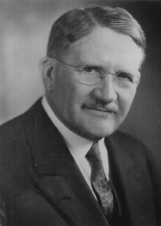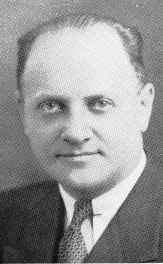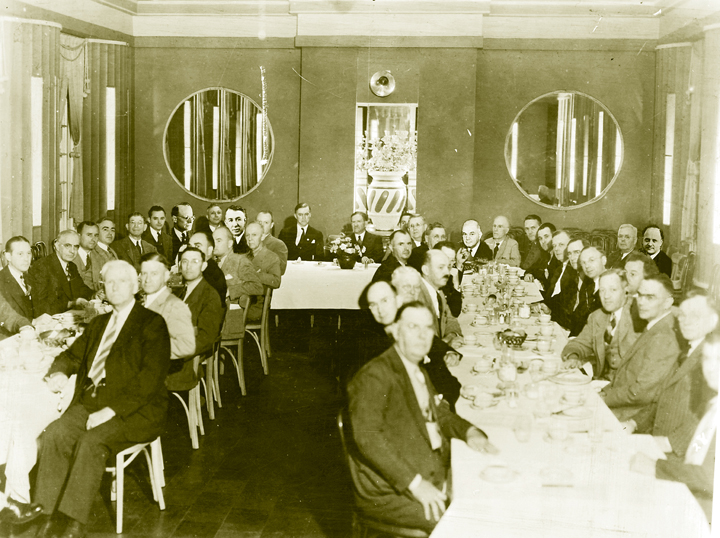The American Public Power Association’s founding was thanks to a group of leaders that fought to both develop and retain public ownership in their communities and had the passion to support others in doing so.
E.F. Scattergood, who helped establish the electric services arm of the Los Angeles Department of Water and Power in the 1910s, led efforts to develop an association starting as early as 1934, when leaders gathered in Kansas City to form the National Association of Municipal Utilities. While that effort failed to get off the ground, Scattergood and other prominent leaders kept working to form an alliance that would promote “competent and non-political administration of publicly owned electric utilities.”

In September 1940, a group of about 40 public power utility leaders from across the country gathered in Washington, D.C. to officially form the American Public Power Association. The meeting was timed to coincide with a government-sponsored meeting on national defense, which various public power utility leaders were attending. The meeting included representatives from public power entities big and small and some federal agencies. The attendees also selected APPA’s first board of directors, naming James Donovan of Kansas City president, Scattergood first vice president, and Frank King, superintendent of utilities in Burlington, Vermont, as executive vice president. The first board met in Kansas City in October 1940 and included representatives from more than a dozen utilities.
No dedicated association staff existed until fall 1941, when Harold Kramer, secretary and general manager of Loup Power District in Nebraska, agreed to serve temporarily as APPA’s first “secretary-manager” and set up a small office in Washington, D.C. He led the association from November 1941 to June 1942.
Prior to getting APPA off the ground, Kramer was a force that not only developed Loup Power District but advocated for the enablement of public power districts across the state of Nebraska and the financing mechanisms that made their signature generation projects possible.
Scattergood’s efforts to build hydroelectric plants to serve Los Angeles made way for the public power utility to acquire its distribution system from private companies that had previously managed it. He was also pivotal in securing Congressional approval for building the Hoover Dam (then called the Boulder Canyon Project) and the transmission infrastructure that would bring electricity to Southern California, fueling its growth.

In December 1941, Kramer told Electrical World magazine that the association was to be a “service rather than crusading organization — self-improvement by exchange of information and ideas is the underlying feature. But, make no mistake about it, we intend to defend against the onslaughts on public power on whatever front they may appear.”
To the Lincoln Journal Star, Kramer stated the early objectives of the association were to “promote cooperation between members, advance their common purposes, and aid in problems of management and operation, engineering, accounting and commercial practice, legal policy and others.”
In APPA’s first years, public power entities faced pressure from federal agencies to rapidly increase generation to support industries backing the war effort. Along with concerns over meeting this load came questions about project finance and developing transmission interconnections.
Continued Cooperation
These past investments allow public power utilities to continue serving their communities reliably and affordably, including through ongoing connection to APPA.
“Having the basis be this gentleman who was our first general manager here at the power district lead that charge really makes me proud to be part of Loup Power District and to be a good member of APPA,” said Neal Suess, who has been president and CEO of Loup Power District since 2005.
When asked about the value he’s seen from continued participation in the association, he pointed to the relationships fostered over his decades in the industry.
“You get hooked up with consultants, others in the utility business [with whom] you have a common goal and a common thread with that you can really just talk about the issues of the day,” said Suess. “Without the association, you don't make those connections.”
He has attended conferences and participated in various working groups and knowledge sharing initiatives. Suess said those activities and the information shared in APPA’s news and the community groups on APPA Engage has helped him make sense of industry trends.

David Hanson, Senior Assistant General Manager of Power System at LADWP, noted that as part of an effort to bring the utility “back to basics,” there is a renewed focus on its history, with particular emphasis on the founders’ intent to serve the community.
“We brought a very large black and white photo of Ezra Scattergood into a board meeting,” said Hanson. “I reminded the board that it's poetic that the generation facility that kept the lights on through last September’s heat storm and through the Palisades Fire is the Scattergood Generating Station.”
Hanson said much of the focus on improvements stemmed from lessons following the 2025 Palisades Fire. The aftermath of the fire was the first time he was aware that LADWP received mutual aid, when crews from the Navajo Tribal Utility Authority and Pacific Gas & Electric came to help. Hanson said that operations crews from LADWP have routinely participated in mutual aid, including efforts to help Puerto Rico following Hurricane Maria.
As one of the largest public power utilities, and one so connected to APPA’s founding, Hanson hopes LADWP will take greater part in collaborating with other public power utilities such as through sharing best practices and challenges “so that everybody can learn together.” He noted specific interest in how other utilities are addressing city procurement policies and implementing new generation technologies.
“If we can point to other municipalities out there that are embracing [small modular reactors], we need that collaboration and we need that proof of concept, and we only get that through collaborations and partnerships through APPA,” said Hanson.
Darren Springer, general manager of Burlington Electric in Vermont, also noted the value of knowledge exchange. Among other venues, Burlington Electric has been active in APPA’s research and development program, Demonstration of Energy and Efficiency Developments, or DEED.
“We've had opportunities for learning from various municipals around the country through APPA. Sometimes we're able to share examples of things that we're working on that are relevant to other utilities. And that's amazing, because that means the impact of our work can go beyond Burlington, and vice versa,” he said.
Defending the Model
Alonzo Weaver, senior vice president and chief operating officer at Memphis Light, Gas and Water in Tennessee, another charter member, emphasized the value in collaboration.
“The network that APPA provides has given us resources to address many common issues that municipally owned utilities share,” he said, citing support around broadband implementation and navigating supply chain disruptions.
Weaver also pointed to the preservation of tax-exempt financing for capital work as having a positive impact on MLGW’s ability to provide energy at the lowest cost.
“Without APPA’s advocacy, we would be paying higher interest rates on our bonds and our customers would either have higher rates or less projects, and neither of those are good outcomes,” added Springer.
Tax-exempt financing is one of several issues the national network has worked to advance.
“Anytime you have a national organization representing utilities from all different states, different regulatory environments, not everyone's going to be on the same page on every issue,” said Springer.
“If we stick together, we can get more accomplished and I believe that's the essence of these associations,” said Hanson. “The American Public Power Association is where we can find strength in numbers, from the largest public power to the smallest public power. APPA gives us that voice in Washington that allows us to push things on a federal level that we can't necessarily take part in at our local municipal level.”
Terry Wimberley, President and CEO of the Paris Board of Public Utilities in Tennessee, highlighted the “camaraderie, the programs, and the training” participation in associations brings, including at the annual Legislative Rally, which he has attended for the last 10 years.
“I very much enjoy getting to be a voice for public power and am thankful that APPA has the folks in Washington operating at that level, paying attention to all the things that matter in the public power world and helping to protect the public power model,” said Wimberley.
“Our world right now is as crazy as it's ever been… trying to keep up with all the changes that are going on every single minute of every single day, it's too much for us to do at our individual utility levels,” said Suess. “I've gotten to get to know some of our congressional leaders on a first name basis, to where they will call me if they have a concern about something in our industry and then I can contact them back — and that really started with a lot of the things that APPA puts together.”
Future Roles
Public power leaders pointed to several areas where they expect APPA to continue its mission of supporting members.
Looking ahead, Weaver at MLGW hopes to see coordinated efforts around the impacts of tariffs and how public power systems are addressing rapidly increasing electric demand as well as shifts in generating technologies.
“We've all got a responsibility to train the folks behind us and create a deep bench,” said Hanson.
Hanson expects this to extend to educating students and the general public as well. “We've got to be able to talk about the issues that are facing the power system in an easy-to-understand way,” he said.
“Electric utilities are going to play a more critical role in our energy system in the future, which is saying something because they're pretty critical as it is,” said Springer. “Our philosophy is that more customers over time are going to be relying on the electric grid, not just for turning the lights on, but for their transportation needs, for their heating and cooling needs, in [other ways] that they haven't necessarily in the past. And that means that our work collectively as electric utilities is going to be critically important for the nation's economy, for our local economies, for our environment, and for our customers.”
Much like the leader many decades before him, Suess sees a continued opportunity for public power to grow across the country, and for APPA to help communities get municipalization initiatives across the line.
“I really see public power growing in the future… There’s no way we can go but up from here,” he shared.

